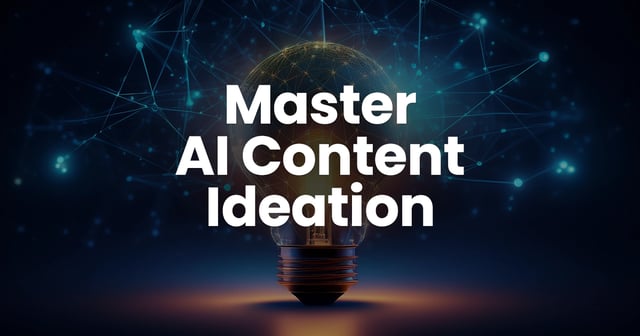Master AI Content Ideation: End Writer’s Block & Fuel Your Calendar

Embrace AI Content Ideation to End Writer’s Block
Is a blank content calendar your recurring nightmare? You’re not alone. The constant demand for fresh, engaging material can be a significant challenge. This is where AI content ideation comes into play, offering a powerful solution. Artificial Intelligence, particularly Large Language Models (LLMs), can act as your tireless brainstorming partner. These models are sophisticated pattern-matching engines; your prompt is the crucial instruction that guides them to unlock vast creative potential. This guide offers practical, actionable strategies for effective AI content ideation, enabling you to spark new ideas and consistently fill your content pipeline.
Crafting Effective AI Prompts: Your “Magic Wand”
Effective AI content ideation hinges on the quality of your prompts. A well-constructed prompt acts as a clear and precise brief for your AI assistant, dramatically increasing the chances of receiving relevant and inspiring suggestions.
Be Crystal Clear & Super Specific: This is the golden rule of prompt engineering. LLMs don’t infer intent like humans do; ambiguity is a primary cause of misinterpretation and irrelevant responses. Clearly state your desired task, the topic, your target audience, any constraints, and the expected outcome.
- Instead of: “Blog ideas about social media.”
- Try: “Generate 5 blog post titles about using TikTok for B2B marketing, targeting marketing managers in the tech industry. Focus on case studies or actionable strategies.”
Give Rich Context: Providing sufficient background information is vital for the AI to tailor its suggestions effectively. This could include the purpose of the content, details about your target audience (their pain points, interests), or even summaries of content you’ve already published to avoid repetition.
- Prompt Example: “Context: Our company sells artisanal coffee beans online. Our audience values ethical sourcing and unique flavor profiles. We’ve recently posted about brewing methods. Task: Suggest 3 Instagram story ideas that highlight the origin story of a new single-origin bean from Ethiopia.”
Assign a Persona: Instructing the AI to adopt a specific persona (e.g., “expert copywriter,” “seasoned travel blogger”) powerfully shapes the tone, style, and even the type of expertise reflected in the generated ideas.
- Prompt Example: “You are a highly experienced financial advisor specializing in retirement planning for millennials. Generate 5 engaging blog post ideas that address common anxieties young people have about saving for the long term.”
Specify Your Desired Format: Don’t leave the structure of the output to chance. Clearly tell the AI how you want the ideas presented (e.g., bullet points, numbered list, table). This makes the AI’s response easier to use.
- Prompt Example: “Provide the ideas as a numbered list. Each idea should include: 1. A potential headline (under 70 characters). 2. A brief 1-2 sentence description of the angle.”
Iterate, Iterate, Iterate! Your first prompt rarely yields the perfect result. Prompt engineering is fundamentally an iterative process. Test your prompts, evaluate the output, and refine your instructions based on the results. This cycle of writing, testing, and refining is key to success.
A Quick Workflow: Integrating AI into Your Content Planning
- Define Pillars & Audience: Before you prompt, be clear on your core content themes and who you are trying to reach.
-
- AI Assist: “Help me develop a more detailed audience persona for my . My current understanding is [general audience description]. What are their likely key demographics, psychographics, and common pain points related to [your industry/niche]? Format as a bulleted list.”
- Dedicated AI Brainstorming Session: Armed with your strategy, use clear prompts (as detailed above) with your chosen AI tool (e.g., ChatGPT, Google’s Gemini, Anthropic’s Claude, or specialized idea generation platforms).
-
- Prompt Example (combining elements): “Persona: You are a leading content strategist for B2B SaaS companies. Task: Generate 10 unique blog post ideas. Context: My company provides AI-powered analytics software. Our target audience is data analysts and marketing VPs in mid-sized e-commerce businesses. We want to highlight how our tool uncovers hidden revenue opportunities. Format: For each idea, provide a compelling title, a 2-sentence concept summary, and suggest 2-3 primary keywords.”
- Refine & Humanize: AI provides a fantastic starting point, but human oversight is crucial. Use your expertise and brand knowledge to select the most promising ideas, combine concepts, and inject your unique voice and perspective.
- Outline with AI Assistance: Once you’ve chosen an idea, AI can help structure it.
-
- Prompt Example: “Take the blog post idea: ‘[Chosen AI-Generated Idea Title]’. Task: Generate a comprehensive outline for this post. Include an introduction with a strong hook, 3-5 main body sections (each with 2-3 supporting bullet points), and a concluding paragraph with a call to action.”
Advanced AI Ideation Tactics for Fresh Angles
Repurpose Existing Content: Maximize your efforts by giving old content new life.
- Prompt Example: “Context: I have an in-depth blog post titled ‘[Your Existing Blog Post Title]’ which explains [brief summary of post]. Task: Generate 3 ideas for short LinkedIn articles and 3 Twitter thread hooks based on the key takeaways from this existing post. The tone should be professional and insightful.”
Explore “Shoulder Content” (Related Niches): Expand your reach by tapping into topics adjacent to your core expertise that still resonate with your target audience.
- Prompt Example: “My primary content topic is ‘sustainable home organization.’ What are 5 ‘shoulder’ content topics that would appeal to an audience interested in both organization and eco-conscious living? For each, suggest a content format (e.g., blog, infographic, checklist).”
Use “Chain-of-Thought” for Deeper Ideation (Model Dependant): Encourage the AI to “think step-by-step” to uncover more nuanced ideas. This involves prompting it to break down a problem or topic before generating final suggestions.
- Prompt Example: “I need a pillar content idea explaining ‘[complex industry trend, e.g., the rise of zero-party data]’ to ‘[your audience, e.g., e-commerce managers]’. Task: First, outline the key components and implications of this trend step-by-step. Consider the challenges and opportunities it presents. Then, based on this detailed breakdown, propose 3 distinct pillar page titles, each with a short abstract outlining its unique focus.” (Note: OpenAI explicitly advises against chain-of-thought for its o-series reasoning models, as they perform reasoning internally ).
Conclusion: Your AI Brainstorming Partner Awaits
AI is not here to replace your creativity as a marketer; it’s here to augment it. By mastering the art of crafting clear, specific, and contextual prompts, you can transform LLMs into powerful co-pilots in your fight against writer’s block. The key is to experiment, iterate on your prompts, and combine AI’s suggestions with your strategic insights. Embrace this technology, and turn that daunting blank calendar into an exciting pipeline of engaging, impactful content.
Ready to Start Your AI Content Ideation Journey? Give These a Try!
The best way to master AI content ideation is to start experimenting. The prompting principles and workflow discussed in this post can be applied to various Large Language Models. Here are links to some of the leading platforms where you can begin practicing your new skills:
Gemini: Explore Google’s latest models and conversational AI capabilities.
- Visit: gemini.google.com
ChatGPT: Interact with OpenAI’s popular model known for its versatility in text generation.
- Visit: openai.com/chatgpt/overview/
Claude: Try Anthropic’s AI assistant, designed with a focus on helpfulness, honesty, and harmlessness.
- Visit: claude.ai
Remember to apply the techniques for clear instructions, providing context, assigning a persona, and iterating on your prompts to get the best content ideas from these powerful tools!
What are your favorite AI prompts or tools for brainstorming content ideas? Share your successes in the comments below!







Responses